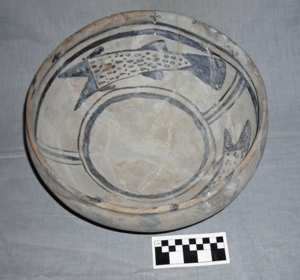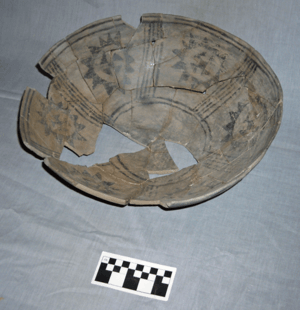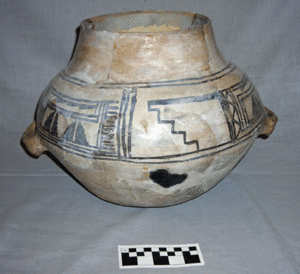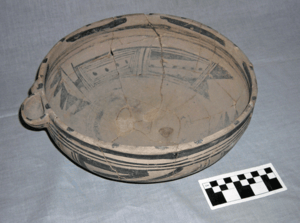Rio Grande White Ware facts for kids
The Rio Grande white wares are special kinds of pottery made by the ancient Puebloan peoples in New Mexico. Starting around AD 750, these potters began creating unique black-on-white pottery. They used black paint on a white, off-white, or light gray background.
At first, they used black paint made from minerals. After AD 1200, they switched to black paint made from plants. This tradition of black-on-white pottery eventually stopped around AD 1750.
Archaeologists, who study ancient cultures, divide these potteries into different "types." This helps them figure out how old a site is. They look at things like the clay, what was mixed into it (called temper), the smooth coating (slip), the paint, and the designs to identify each type.
Contents
What Are Rio Grande White Wares?
Rio Grande white wares were made in the Rio Grande valley and nearby areas. This stretched from the Taos region down to San Marcial. A key feature of these potteries is their black designs on a smooth, often white or light gray background.
Potters created these colors by firing the pottery in a special oven (kiln) with very little oxygen. This process made the clay turn white or light gray. Even though they all shared this black-on-white style, the different groups of potters had their own unique ways of making and decorating their pottery.
The very first black-on-white pottery in this area was part of a larger style called Cibola White Ware. This style was found across a wide region. For example, a type called Red Mesa Black-on-white was common in the Rio Grande area during the Pueblo II Period.
Over time, local pottery styles started to appear. Early on, like the Cibola style, the black paint was made from minerals. But after AD 1200, potters started using black paint made from plants. By 1750, the black-on-white pottery tradition had mostly disappeared among the Rio Grande Pueblo people. However, some modern potters, especially at Acoma Pueblo, have brought this beautiful tradition back to life.
Archaeologists have named many different types of Rio Grande white wares. We'll look at a few examples to understand how they are different.
Different Kinds of White Wares
Early Styles: San Marcial and Socorro
- San Marcial Black-on-white (AD 750–950): This was an early type found along the Rio Grande. It had simple designs painted with mineral paint. You can tell it apart by its off-white clay mixed with sand and crushed rock. The pottery walls were thick, and the surfaces were polished but usually not slipped (a thin, smooth coating).
- Socorro Black-on-white (AD 1050–1300): Made in the same general area later on, this pottery had very carefully made designs. The black mineral paint often looked "crazed" (like tiny cracks). Bowls of this type were only painted on the inside.
Northern Rio Grande Styles
A different black-on-white tradition started with Kwahe’e Black-on-white.
- Kwahe’e Black-on-white (AD 1050–1250): This type was influenced by the Cibola tradition. It used mineral-based black paint and clay mixed with crushed pottery pieces (sherds). Unlike some other types, Kwahe’e pottery was often unslipped or had a very thin slip. The designs were sometimes not as neat.
- Santa Fe Black-on-white (AD 1250–1350): After 1200, potters in this tradition switched to a watery-looking black paint made from plants. This is when the pottery style became known as Santa Fe Black-on-white.
- Wiyo Black-on-white (AD 1300–1400): After 1300, the pottery became even whiter, and the black paint became darker. The designs were carefully polished. This type is thought to have been made by the ancient Tewa people.
Galisteo and Rowe Styles
- Galisteo Black-on-white (AD 1300–1400): This pottery had a thick, white, and often shiny slip on the inside that looked "crackled." If you looked at a broken piece, you'd see a darker core inside the clay. It also had angular crushed pottery pieces mixed in. Bowls were only decorated on the inside. Sometimes, there were small dots of paint on the rim, which might connect it to pottery from the Mesa Verde region.
- Rowe Black-on-white: This was a simpler, rougher version of Galisteo Black-on-white, made in the upper Santa Fe and Pecos river areas.
Jemez River Area Pottery
Pottery from the Jemez River area had its own series of types:
- Vallecitos Black-on-white (AD 1250–1400): Bowls had a thick white slip and dark black paint that was thoroughly polished on the inside. Like Galisteo, it often had dots on the rim, suggesting a link to Mesa Verde pottery. The outside of the bowls was not painted.
- Jemez Black-on-white (AD 1300–1750): This type followed Vallecitos. It included painted designs on the outside of the pottery as well as the inside.
Pajarito Plateau and Northern Styles
After 1375, potters in the Pajarito Plateau area started using a soft, gray clay that made thicker, distinctly gray pots.
- Biscuit A (or Abiquiu Black-on-gray) (AD 1375–1450): These bowls were slipped and decorated only on the inside.
- Biscuit B (or Bandelier Black-on-gray) (AD 1400–1550): These bowls were slipped and decorated on both the inside and outside.
- Sankawi Black-on-cream (AD 1500–1650): This pottery had cream-colored surfaces, thinner walls, and harder clay with a reddish tint. Later, red paint was added to the designs, leading to the Tewa Polychrome tradition we see today.
Even farther north, in the Taos area, there were specific types:
- Taos Black-on-white (AD 1150–1250): This pottery featured designs that looked like the "Dogoszhi style" (with hatched lines), but they were not always perfectly done. It used black mineral paint on white polished surfaces.
- Vadito Black-on-white (AD 1325–1600): This type used black paint made from plants on white-slipped backgrounds.





